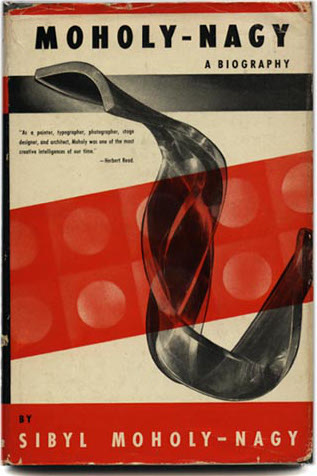Sibyl Moholy-Nagy: Moholy-Nagy – Experiment in Totality (1950–)
Filed under book | Tags: · architecture, art, art history, bauhaus, biography, constructivism, graphic design, history of architecture, painting, typography

“This biography of the Constructivist leader László Moholy-Nagy illustrates his struggle for a total approach to seeing-teaching-creating. Written by Sibyl Moholy-Nagy, László’s second wife and lifetime collaborator, she witnessed many of the defining moments of the Bauhaus movement and its migration to the United States and its continuation as the Chicago New Bauhaus and Institute of Design. An excellent first-person account.”
With an Introduction by Walter Gropius
Publisher Harper & Brothers, New York, 1950
262 pages
Second edition
Publisher MIT Press, 1969
xviii+259 pages
PDF (1950)
Internet Archive (1950, multiple formats)
PDF (2nd ed., 1969, added on 2020-1-3)
László Moholy-Nagy: The Art of Light (2010) [Spanish]
Filed under book, catalogue | Tags: · art, avant-garde, bauhaus, constructivism, film, graphic design, light art, painting, photography, sculpture, typography

An artist and thinker of astounding energy and ability, Laszlo Moholy-Nagy was a true world citizen of the early twentieth century, an ambassador-at-large for Constructivism, Suprematism, Dada and the Bauhaus. He brought the same Constructivist optimism to every medium he tackled, from plexiglass and light sculpture to typography to his photographic experiments in color to his Suprematist canvases, his influential pedagogy at the Bauhaus and at the Institute of Design in Chicago. Moholy-Nagy’s concept of the arts as a totality, his pedagogy and his confidence in the new industrial culture that would level distinctions between art and craft led him into all fields of creative production. The ultimate modernist Renaissance man, Moholy-Nagy was prolific in so many realms that his detractors inevitably charged him with dilettantism. This accusation ignores his very real innovations in photography–for example his photograms–and light sculpture, as well as the fact that the artist’s aims possessed a conceptual unity in their common aspiration to make an “art of light.”
László Moholy-Nagy: The Art of Light presents Moholy-Nagy’s work in all of its glorious unity and diversity. Including more than 200 works, from painting, photography (black and white and color) and photograms to collages, films and graphic design, it emphasizes his greatest years of productivity, from 1922 to the end of his life. The Art of Light is the new definitive volume on this hero of modernism.
László Moholy-Nagy: El Arte de la Luz
Book coordination: Doménico Chiappe, Luisa Lucuix
Editor: Emilio Ruiz Mateo
Publisher: La Fábrica Editorial / Círculo de Bellas Artes, Madrid
ISBN: 8492841257, 9788492841424
264 pages
exhibition (Madrid, 2010)
Comment (0)Michael Fried: Art and Objecthood: Essays and Reviews (1998)
Filed under book | Tags: · 1960s, 1970s, abstract expressionism, art criticism, art history, cubism, minimal art, painting, sculpture

“Much acclaimed and highly controversial, Michael Fried‘s art criticism defines the contours of late modernism in the visual arts. This volume contains twenty-seven pieces, including the influential introduction to the catalog for Three American Painters, the text of his book Morris Louis, and the renowned Art and Objecthood. Originally published between 1962 and 1977, they continue to generate debate today. These are uncompromising, exciting, and impassioned writings, aware of their transformative power during a time of intense controversy about the nature of modernism and the aims and essence of advanced painting and sculpture.
Ranging from brief reviews to extended essays, and including major critiques of Jackson Pollock, Morris Louis, Kenneth Noland, Jules Olitski, Frank Stella, and Anthony Caro, these writings establish a set of basic terms for understanding key issues in high modernism: the viability of Clement Greenberg’s account of the infralogic of modernism, the status of figuration after Pollock, the centrality of the problem of shape, the nature of pictorial and sculptural abstraction, and the relationship between work and beholder. In a number of essays Fried contrasts the modernist enterprise with minimalist or literalist art, and, taking a position that remains provocative to this day, he argues that minimalism is essentially a genre of theater, hence artistically self-defeating.
For this volume Fried has also provided an extensive introductory essay in which he discusses how he became an art critic, clarifies his intentions in his art criticism, and draws crucial distinctions between his art criticism and the art history he went on to write. The result is a book that is simply indispensable for anyone concerned with modernist painting and sculpture and the task of art criticism in our time.”
Publisher University of Chicago Press, 1998
Art History series
ISBN 0226263193, 9780226263199
333 pages
PDF (10 MB, updated on 2019-6-9)
Comment (0)
